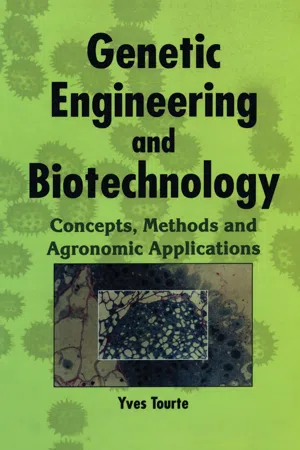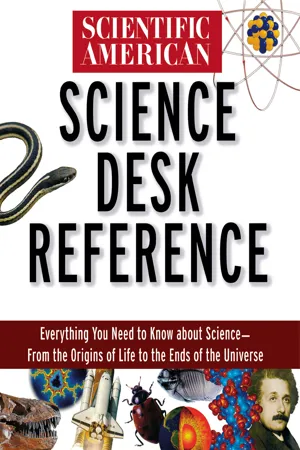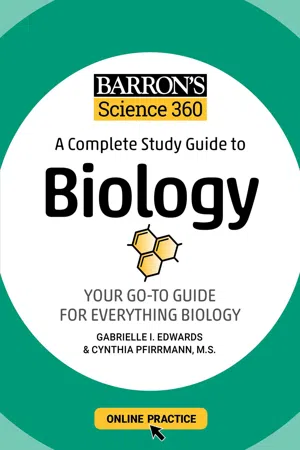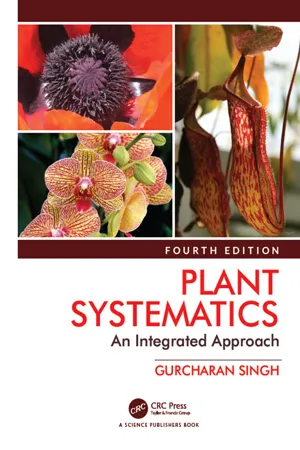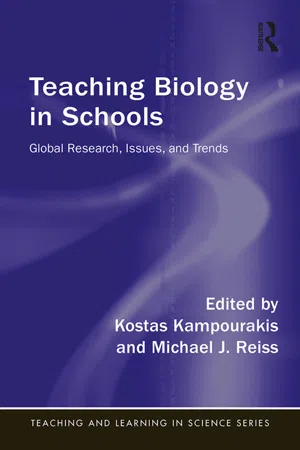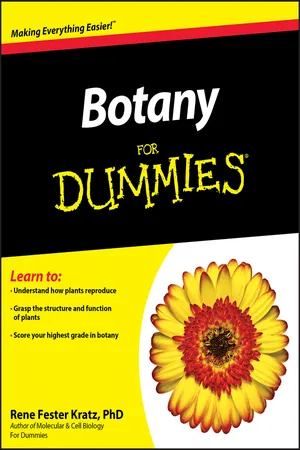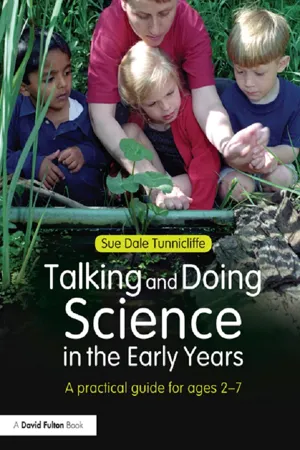Biological Sciences
Plants
Plants are multicellular organisms that belong to the kingdom Plantae. They are characterized by their ability to photosynthesize, using chlorophyll to convert light energy into chemical energy. Plants play a crucial role in the ecosystem by producing oxygen, providing food for other organisms, and contributing to the cycling of nutrients.
Written by Perlego with AI-assistance
Related key terms
7 Key excerpts on "Plants"
- eBook - ePub
Genetic Engineering and Biotechnology
Concepts, Methods and Agronomic Applications
- Yves Tourte(Author)
- 2019(Publication Date)
- CRC Press(Publisher)
animals according to whether or not they are equipped and able to use light energy. A preliminary approach to the classification of living organisms is thus based on three major, clearly distinguished groups. There are also intermediate groups, often constituting interesting transitions that merit a closer look.b) Definition of a plant
Generally, a plant is defined by its capacity to use light energy, i.e., energy linked to light radiation, to combine water molecules and carbon atoms to synthesize sugars. The sugars constitute energy reserves that allow plant cells to carry out all the other syntheses necessary for their metabolism. This carbon-based autotrophy of Plants is based on the presence of specific pigments such as chlorophylls, while animals, which do not have this capacity for synthesis, use plant sugars and are thus entirely dependent on Plants. They are situated further along the food chain. This essential criterion, however, is not the only one and normally the following criteria are added, in no particular order.- the existence of meristems, which give Plants a constant and indefinite growth;
- a general totipotency of cells that preserves the capacity of regeneration throughout the life of the plant, i.e., the ability to recreate a new plant;
- meiosis, which results in the differentiation of spores and not gametes;
- an alternation of generations, gametophyte and sporophyte , separated by fertilization and meiosis;
- the presence of rigid framework of cellulose around each cell;
- the existence of a triple heredity—nuclear, plastidial, and mitochondrial;
- a kinetic apparatus that has some variability in its organization, for example, centrioles replaced by polar crowns;
- male gametes that do not always have the capacity for autonomous displacement;
- a fixed life.
c) Frontiers of the plant kingdom
With prokaryotesSome bacteria are also photosynthetic because of the presence of chlorophyllian pigments (bacteriochlorophylls). At this frontier of the plant kingdom are found the Cyanobacteria or blue bacteria, which were earlier called blue algae. They are bacteria because they have no nuclear compartment but are classified among the algae on the basis of the vegetative organization, which can be as evolved as that of other algal groups (nematothallus and cladothallus). These cyanobacteria are also distinguished by the differentiation of a complex photosynthetic structure, the chromoplasm, which associates concentric membranes and pigments dissolved in lipidic drops (Fig. 1.1 ). They are perfectly autotrophic for carbon. The genera Nostoc and Oscillatoria - eBook - ePub
- (Author)
- 2008(Publication Date)
- Trade Paper Press(Publisher)
HE PLANT KINGDOMAt least a quarter of a million species make up the plant kingdom. From mosses and ferns to the more complex conifers and flowering Plants, they are all primarily adapted to life on land, develop from embryos, carry out photosynthesis, have complex cells surrounded by a rigid cellulose wall, and do not move around. A few parasitic Plants have lost the ability to photosynthesize but are still considered to be Plants.Plants are autotrophs , that is, they are able to nourish themselves by harnessing the energy of sunlight to make carbohydrates from water and carbon dioxide. They and other autotrophs are the primary producers in all food chains since the materials they synthesize and store are the energy sources of all other organisms. Plants also play a vital part in the carbon cycle, removing carbon dioxide from the atmosphere and generating oxygen.The study of Plants is botany (from the Greek botane for “herb”). It is divided into a number of specialized studies, such as the identification and classification of Plants (taxonomy), their external formation (plant morphology), their internal arrangement (plant anatomy), the microscopic examination of their tissues (plant histology), their functioning and life history (plant physiology), and their distribution over the earth’s surface in relation to their surroundings (plant ecology). Paleobotany concerns the study of fossil Plants, while economic botany deals with the utility of Plants. Horticulture, agriculture, and forestry are also branches of botany.history of botany
Although the study of Plants might be said to date back more than 10,000 years, when people first learned to cultivate crops, the earliest known botanical record is that carved on the walls of the temple at Karnak, Egypt, about 1500 BC . The Greeks in the 5th and 4th centuries BC used many Plants for medicinal purposes, the first Greek “Herbal” being drawn up about 350 BC - Gabrielle I. Edwards, Cynthia Pfirrmann(Authors)
- 2021(Publication Date)
- Barrons Educational Services(Publisher)
9THE GREEN Plants
WHAT YOU WILL LEARN
In this chapter, you will be taken on a journey through the kingdom of the green Plants. Some green Plants are very small, consisting of a single cell. Other members of the Plantae, such as the giant sequoias in California, are enormous. You will learn why organisms of such diversity are classified in one kingdom.SECTIONS IN THIS CHAPTER•General Characteristics of Plants•Major Divisions of Plants•Photosynthesis•Plant Hormones•Photoperiodicity•Review Exercises•Connecting to Life/Job Skills•Chronology of Famous Names in BiologyGeneral Characteristics of Plants
Taxonomists group all green Plants in the kingdom Plantae. Members of the Plantae are multicellular. Although multicellular means “having many cells,” the concept of multicellularity involves more than numbers of cells. It embraces several ideas about cell structure and function. One such idea concerns cell specialization in which cells are “programmed” to carry out special tasks. Cell specialization in multicellular Plants also brings with it a division of labor in which groups of cells in tissue formation work together to perform some special life function of benefit to the entire plant organism. Another condition necessary to all specialization is the evolution of cell structures that permit specialization and difference in cell function.As implied in the term green Plants, members of the kingdom Plantae contain the green pigment chlorophyll. Not only does chlorophyll color plant leaves and some stems green, it, more importantly, traps light energy that is used in the process of photosynthesis. As an outcome of photosynthesis nutrient molecules are made, serving as food for both Plants and animals.Species of the kingdom Plantae are terrestrial (land-dwelling), nonmotile, anchored to one place, and unable to move. All Plants reproduce by cycling through phases called gametophyte and sporophyte generations. During this alternation of generations, sporophyte cells go through meiosis to produce haploid spores, containing unpaired chromosomes, which are often dispersed by animals, wind, and weather. The spore undergoes mitosis to become a haploid gametophyte and may ultimately become a gamete (egg or sperm cell). These gametes unite to become a diploid zygote, with paired chromosomes, which will mature into a sporophyte plant, and then the process is repeated. Simpler, more primitive, Plants have a dominant gametophyte generation, while higher Plants maintain a dominant sporophyte generation.- eBook - ePub
Plant Systematics
An Integrated Approach, Fourth Edition
- Gurcharan Singh(Author)
- 2019(Publication Date)
- CRC Press(Publisher)
Before attempting to classify the various organisms, it is necessary to identify and name them. A group of individuals, unique in several respects, is given a unique binomial, and is recognized as a species. These species are grouped into taxonomic groups, which are successively assigned the ranks of genera, families, orders, and the process continues till all the species have been arranged (classified) under a single largest, most inclusive group. Classifying organisms and diverse forms of life is challenging task before the biologists.Figure 1.1: Estimated number of species on earth and the described number of species (solid lower portion of bar) in major groups of organisms. The estimates in recent years have shifted from Animals to Bacteria, Fungi and Protists as dominant groups.Plants AND KINGDOMS OF LIFE
Plants are man’s prime companions in this universe, being the source of food and energy, shelter and clothing, drugs and beverages, oxygen and aesthetic environment, and as such they have been the dominant component of his taxonomic activity through the ages. Before attempting to explore the diversity of plant life it is essential to understand as to what our understanding of the term Plant is, and the position of Plants in the web of life. Traditionally the Plants are delimited as organisms possessing cell wall, capable of photosynthesis, producing spores and having sedentary life. A lot of rethinking has resulted in several different interpretations of the term plant.Two Kingdom System
The living organisms were originally grouped into two kingdoms. Aristotle divided all living things between Plants, which generally do not move or have sensory organs, and animals. Linnaeus in his Systema naturae published in 1735 placed them under Animalia (Animals) and Vegetabilia (Plants) as two distinct kingdoms (Linnaeus placed minerals in the third kingdom Mineralia). Linnaeus divided each kingdom into classes, later grouped into phyla for animals and divisions for Plants. When single-celled organisms were first discovered, they were split between the two kingdoms: mobile forms in the animal phylum Protozoa, and colored algae and bacteria in the plant division Thallophyta or Protophyta. As a result, Ernst Haeckel (1866) suggested creating a third kingdom Protista for them, although this was not very popular until relatively recently (sometimes also known as Protoctista). Haeckel recognized three kingdoms: Protista, Plantae and Animalia - eBook - ePub
Teaching Biology in Schools
Global Research, Issues, and Trends
- Kostas Kampourakis, Michael Reiss, Kostas Kampourakis, Michael J. Reiss(Authors)
- 2018(Publication Date)
- Routledge(Publisher)
Plants are curious organisms—clearly, they are alive but their apparent lack of any central organization (brain, heart, or nervous system) makes it harder for us to understand how they work. They are slow: usually they look today just like they did yesterday and we have to wait, sometimes a long time, to see changes in them.(Van Volkenburgh, foreword in Koller, 2011, p. xiii)However, these characteristics also offer opportunities. Numerous cellular processes in Plants operate at similar rates to their zoological counterparts providing us with ample opportunities to demonstrate many key biological processes, and indeed experiment upon them as models for living organisms more generally. This is emphasised by their use in common practical investigations in the school laboratory, e.g. investigation of osmotic potential on tissue (potatoes), source of enzymes in rate reactions (leaves) and the source of material for lower secondary introduction to cells using microscopes (onion). Yet, this specific use in practical investigations does not always translate into a broader picture of the contribution Plants make to biological science, nor to their role in enabling life on earth. Slingsby (2006), for example, has criticised the role of Plants in school biology as being reduced to “victims in a series of photosynthesis experiments that don’t always work” (p. 51).If this bleak experimental landscape is adjoined to limitations in teacher and student engagement with Plants (Uno, 2009, Nyberg & Sanders, 2014), an emergent problem for society becomes visible. Understanding the contribution of Plants to biological life is vital in an era in which plant extinction numbers are increasing (Willis, 2017) and the climate is changing, much of which is attributed to human activity.Plant-Blindness
The role of Plants in the received curriculum is frequently perceived as separate from animals, and often focused on specific plant topics - eBook - ePub
- Rene Fester Kratz(Author)
- 2011(Publication Date)
- For Dummies(Publisher)
Part V Plants and PeopleIn this part . . .TIn this part, I explore the many ways in which Plants support the lives of people, from their role in nature to the useful products they provide.he lives of Plants and people are interconnected in many ways. Plants play many essential roles in natural ecosystems, from making food to recycling carbon to providing homes for other species. Plants also provide people with useful products, such as food, oxygen, medicines, clothing, and wood.Passage contains an image
Chapter 18 Making Connections with Plant Ecology In This ChapterMastering the fundamentals of ecologyInvestigating plant interactionsExploring plant communitiesPExploring Ecosystemslants are an incredibly important part of life on earth. Plants make the food upon which all organisms rely. They provide homes to many other species, and they are part of the structure of ecosystems. This chapter covers the fundamental principles that underlie the interactions between all species and explores the importance of plant communities in the environment.All life on earth is interconnected — organisms depend on each other for food and are impacted by each other’s actions. Life depends on the environment too, for water, light, minerals, and a place to live.An ecosystemWhatever their size, every ecosystem includes certain components:is a group of living and nonliving things interacting with each other in a particular environment. Ecosystems can be large or small, from the entire web of life interacting with each other and the surface of the earth, called thebiosphere, to a tiny ecosystem in a tide pool along the seashore.Abiotic factors are the nonliving parts of the ecosystem. Abiotic factors include things like sunlight, water, soil, air, and dead materials.Biotic factors are the living components of the ecosystem. Scientists organize the biotic factors into two categories (shown in Figure 18-1):• Populationsare groups of the same species living in the same place. A forest, for example, may include a population of oak trees, a population of salamanders, and a population of squirrels. Even very similar organisms are considered different populations if they aren’t the same species. - eBook - ePub
Talking and Doing Science in the Early Years
A practical guide for ages 2-7
- Sue Dale Tunnicliffe(Author)
- 2013(Publication Date)
- Routledge(Publisher)
Plants are green living organisms. They are green because they contain a chemical, chlorophyll, which enables them to use sunlight’s energy to drive a chemical reaction called photosynthesis, which produces sugars. Chlorophyll is contained in the cells of Plants, which have rigid cellulose walls, unlike animal cells. If a green plant is deprived of light it loses its green colour and turns yellowish white. Plants that still grow without light become long and straggly and lose their green colour.Plants need more than just sunlight!Apart from sunlight to drive the process of photosynthesis, Plants also need elements such as magnesium and potassium. These they obtain from the soil through their roots. Hence, the other big difference (other than being green) between Plants and animals, is that Plants stay still where they grow unlike animals that move searching for food (with few exceptions).Plants are more than just flowersAlthough most children think of ‘Plants’ as the name for flowers, in a similar way to how people generally think of the word ‘animal’ as synonymous with mammals, Plants in fact have a number of distinct groups, including (in everyday language) flowers, fruits, vegetables, weeds, trees, herbs, bushes, grasses, vines, ferns, mosses, fungi and seaweeds. Fungi and the red seaweeds (red algae) are not considered ‘Plants’ by botanists. The everyday grouping of ‘Plants’ is usually assumed to mean flowers. Trees, bushes, fruits, vegetables and weeds are not regarded as flowers by non- scientists. Weeds are considered Plants that grow in places where humans do not want them to. These are not botanical groups but an everyday human utilitarian one that children hear. There are more than 300,000 different kinds of Plants and about two- thirds of them have seeds.
Learn about this page
Index pages curate the most relevant extracts from our library of academic textbooks. They’ve been created using an in-house natural language model (NLM), each adding context and meaning to key research topics.
